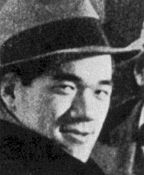Sadao Yamanaka | |
|---|---|
 | |
| Born | November 7, 1909 |
| Died | September 17, 1938 (aged 28) |
| Other names | Kimpachi Kajiwara |
| Occupation(s) | Film director, screenwriter |
| Years active | 1932-1938 |
| Organization | Narutaki-gumi |
Sadao Yamanaka (山中 貞雄, Yamanaka Sadao, November 7, 1909 – September 17, 1938) was a Japanese film director and screenwriter who directed about 24 films between 1932 and 1937, all in the jidaigeki genre, of which only three survive in nearly complete form (all of them sound films).[1][2] He is considered a master filmmaker in his native Japan and one of the greatest talents of his generation alongside Yasujirō Ozu and Kenji Mizoguchi. He was one of the primary figures in the development of the jidaigeki (period drama), especially the samurai subgenre. His films are notable for their emphasis on character over action, and on ninjō over giri.[3] Yamanaka died of dysentery in Manchuria after being drafted into the Imperial Japanese Army. He is the uncle of the Japanese film director Tai Kato, who wrote a book about Yamanaka, Eiga kantoku Yamanaka Sadao.
Kinema Junpo, Japan's leading film magazine, included two of Yamanaka's films (Tange Sazen from 1935 and Humanity and Paper Balloons from 1937) among the top 25 Japanese films of all time, on a list selected by Japanese film experts in 2009.[4] Interest in Yamanaka's work redeveloped after the restoration and Japanese DVD release of the three surviving films. His most internationally discussed film, Humanity and Paper Balloons, was given its first non-Japanese DVD release in the UK as a Masters of Cinema release.
- ^ Sharp, Jasper (21 September 2005). "Midnight Eye review: Humanity and Paper Balloons (Ninjo Kami-fusen, 1937, Sadao YAMANAKA)". Midnight Eye.
- ^ Freiberg, Freda (December 18, 2007). "Yamanaka Sadao's Humanity and Paper Balloons (1937)". In Stringer, Julian; Phillips, Alastair (eds.). Japanese Cinema: Texts and Contexts. Routledge. ISBN 978-1-134-33421-6.
- ^ Richie (2001), p. 73
- ^ "「オールタイム・ベスト 映画遺産200」全ランキング公開". Archived from the original on December 15, 2009. Retrieved October 12, 2024.